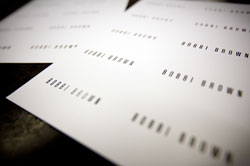> Printing capabilities
Offset
Themography >
Engraving
Embossing
Foil Stamping
Letterpress
Digital
THERMOGRAPHY
a.k.a. raised print, thermo-engraving (a misleading term used by some marketing folks), dimensional printing

Thermography creates a raised effect on images and letters. While commonly used on business cards, letterheads and envelopes, many more creative opportunities include greeting cards, report covers, advertising and packaging materials.
Thermography is produced using a traditional offset press. Thermography can be applied to any freshly printed sheet, whether it is single color, four-color process, or a spot varnish pattern to add texture to a previously printed piece.
With good design being the key, you can have the added attraction of dimension and brightness by using thermography. Making use of the many powders that are available which include clear, matte, pearlescent, fluorescent, and glitter, can turn any printed project into a smart, professional-looking or fun design piece.
Large solids, when thermographed, will often have an orange peel look in the finish. Thermography cannot produce a mirror-like finish that you may get in some types of UV coatings.
The thermography process
1. A printed sheet drops off the printing press onto the conveyor of the thermography machine.
2. The conveyor moves the freshly printed sheet through the powder applicator, covering the entire sheet with thermography powder.
3. The thermography powder attaches to the wet ink.
4. The extra powder is vacuumed up and stored for re-use.
5. The coated sheet passes through an oven with temperatures ranging from 900 to 1300 degrees Fahrenheit.
6. The sheet passes through a cooling tunnel and is stacked.
Laser Safe Thermography
Traditional thermography powder can re-melt when exposed to heat, so if a letterhead is being printed that may be used in a laser printer, you will want to be sure to specify "laser safe thermography". Laser safe thermography is produced using a special powder that is melted in the thermography machine, then is cured using ultraviolet light. This type of thermography cannot re-melt.
What is the difference between thermography and engraving?
Thermography is a plastic resin powder that is added on top of offset printing. Engraving requires a die and special engraving press where the ink becomes a part of the paper. Engraving will produce the telltale bruise on the back of the sheet. Engraving can produce much finer detail.